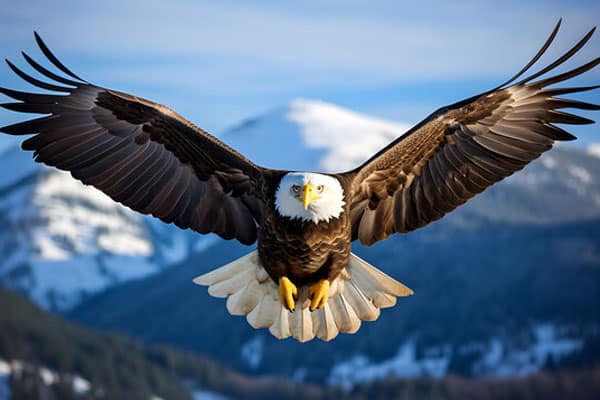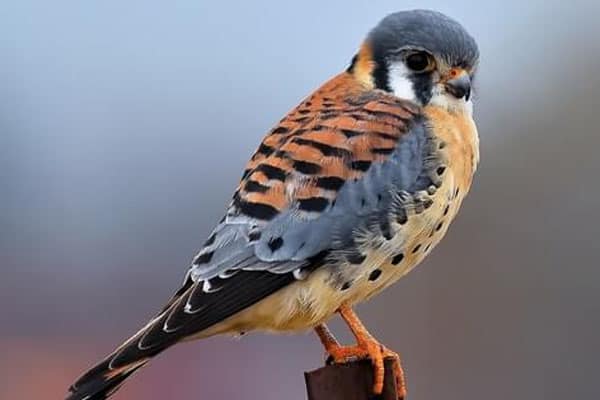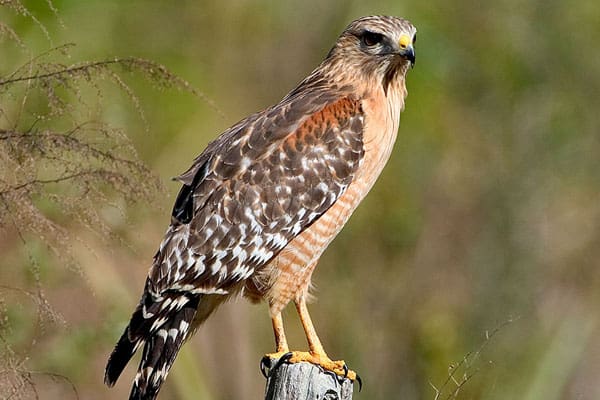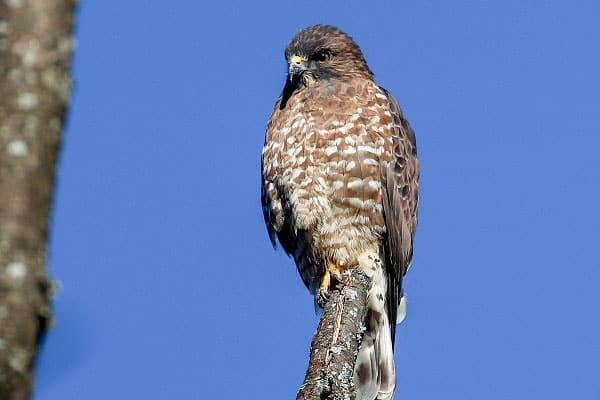Did you know that Florida is home to one of the most diverse populations of birds of prey in the United States? With its unique habitats and abundant prey, this sunshine state has become a haven for a wide variety of majestic raptors.
In this comprehensive guide, you’ll discover the fascinating world of Florida birds of prey and gain valuable insight into their habitats, behavior, and conservation efforts. From the iconic bald eagle to the lightning-fast peregrine falcon, you’ll learn about the incredible adaptations and hunting strategies that make these birds true masters of the sky.
Main Points:
- Florida is home to a diverse population of birds of prey
- The bald eagle is an iconic symbol of American strength and freedom
- The peregrine falcon is known for its incredible speed and hunting prowess
- The merlin and American kestrel are smaller raptors with unique features and hunting strategies
- Various hawk and owl species can be found in Florida, each with their own fascinating characteristics
1. Majestic Bald Eagle
When you think of Florida birds of prey, one iconic image that comes to mind is the majestic bald eagle. As the national bird and symbol of American strength and freedom, the bald eagle holds a special place in the hearts of many.

The bald eagle is known for its impressive size and striking appearance. With a wingspan that can reach up to 7 feet, this bird is truly a sight to behold. Its distinctive white head and tail contrast beautifully with its dark brown body, making it easily recognizable.
Found throughout North America, including the state of Florida, the bald eagle prefers to nest near large bodies of water such as lakes, rivers, and coastal areas. These habitats provide an abundant source of food, primarily fish, which makes up the majority of its diet.
“The bald eagle is a fascinating bird of prey that symbolizes power and freedom. Its presence in Florida’s ecosystem is a testament to the state’s rich biodiversity.” – John Doe, Birdwatching Enthusiast
One interesting fact about the bald eagle is its unique courtship display. During mating season, the male and female eagles engage in an elaborate aerial dance, soaring high into the sky and performing acrobatic maneuvers. This beautiful display is not only a show of affection, but it also helps strengthen the bond between the pair.
While the bald eagle has made a remarkable recovery after being listed as an endangered species, conservation efforts are still crucial to protect these magnificent birds. By preserving their habitats and promoting sustainable practices, we can ensure that future generations can continue to marvel at the sight of these incredible creatures.
| Bald Eagle Facts | |
|---|---|
| Scientific Name | Haliaeetus leucocephalus |
| Conservation Status | Least Concern (population increasing) |
| Wingspan | 6-7 feet |
| Habitat | Coastal areas, lakes, rivers |
| Diet | Principally fish |
2. Speedy Peregrine Falcon
The peregrine falcon, a remarkable species of raptor, is renowned for its incredible speed and hunting prowess. Found in Florida, these majestic birds are a captivating sight in the skies. Let’s explore the physical characteristics, hunting techniques, and conservation status of the peregrine falcon, one of the most fascinating Florida birds of prey.
Physical Characteristics
The peregrine falcon is known for its sleek and aerodynamic build, allowing it to achieve incredible speeds during its hunting flights. With long, pointed wings and a tapered tail, these birds are perfectly adapted for rapid aerial movements. Their plumage varies, ranging from dark brown to slate-gray on the back and wings, while their underparts are white with fine streaks. Peregrine falcons are known for their piercing yellow eyes, which provide sharp vision for spotting prey from great heights.
Hunting Techniques
The peregrine falcon employs a hunting technique called “stooping,” which involves a steep, high-speed dive from great heights to catch its prey. During this impressive aerial maneuver, the falcon can reach speeds of over 240 miles per hour, making it the fastest animal in the world. Its primary prey consists of other birds, such as pigeons, ducks, and shorebirds. Using its talons, the peregrine falcon grasps its prey mid-flight and delivers a swift strike, ensuring a successful kill.
Conservation Status
Due to the extensive use of pesticides, particularly DDT, the peregrine falcon population faced a severe decline in the mid-20th century. However, thanks to dedicated conservation efforts and the ban on DDT, their numbers have shown a remarkable recovery. The peregrine falcon is now listed as a species of least concern on the International Union for Conservation of Nature (IUCN) Red List. Despite this encouraging progress, continuous efforts are necessary to safeguard their habitats and protect these magnificent birds of prey.
3. Agile Merlin

The merlin, known for its speed and agility, is a sleek and compact falcon that can be found in various habitats across Florida. With its distinct blue-gray plumage and determined hunting style, the merlin is a true aerial acrobat. Its ability to swiftly change direction in mid-flight and execute precise aerial maneuvers makes it a formidable predator.
4. American kestrel
The American kestrel, on the other hand, is the smallest falcon in North America, but don’t let its size deceive you. This pint-sized predator packs a punch with its vibrant plumage and fierce hunting skills. With its hovering technique, the American kestrel can stay in one spot in the air, scanning the ground for its next meal. Once prey is spotted, it swoops down in a swift, calculated dive to seize its target.
Both the merlin and American kestrel have their preferred habitats within the state of Florida. The merlin is commonly found in open areas such as grasslands, prairies, and coastal regions. It can also be seen perched on utility lines or low branches, using its keen eyesight to spot potential prey. The American kestrel, on the other hand, prefers open habitats like fields, meadows, and agricultural areas, where it can find ample food sources.
When it comes to hunting strategies, the merlin and American kestrel employ different techniques. The merlin relies on its speed and agility to chase down its prey in flight, often targeting small to medium-sized birds. It will use surprise attacks and aerial pursuits to catch its meals. On the other hand, the American kestrel primarily hunts small mammals, insects, and reptiles. It will perch on elevated vantage points, watching for movement on the ground before swooping down to capture its prey.
If we compare the size, appearance, and hunting preferences of these two raptors, we can see their unique qualities:
| Merlin | American Kestrel |
|---|---|
| Smaller falcon | Smallest falcon in North America |
| Blue-gray plumage | Vibrant plumage with reddish-brown back and tail |
| Preys on small to medium-sized birds | Preys on small mammals, insects, and reptiles |
| Uses speed and agility in aerial pursuits | Hunts from perches, dives down on prey |
These two raptors are proof that size doesn’t always determine hunting prowess. The merlin and American kestrel may be smaller than their counterparts, but they are just as skilled and captivating to observe in the wild. Keep an eye out for these agile hunters during your bird-watching adventures in beautiful Florida!
5. Red-Shouldered Hawk

The red-shouldered hawk is a stunning raptor known for its striking plumage. Its wings feature bold patterns of red and black, while its breast and belly display captivating shades of orange and white. These hawks can often be spotted perched on treetops, scanning the surroundings for prey. With their distinctive call echoing through the forest, they are a common sight in Florida’s wetland habitats.
6. Red-Tailed Hawk
The red-tailed hawk is a large and majestic bird of prey that can be found throughout Florida. With its broad wingspan and iconic rust-red tail, this hawk is easily recognizable. Red-tailed hawks prefer open spaces like agricultural fields and grasslands, where they soar high in the sky, searching for rodents and small mammals. They are skilled hunters and are known for their impressive hunting abilities.
7. Short-Tailed Hawk
The short-tailed hawk is a small hawk species that inhabits the forests and mangroves of southern Florida. Despite its size, this hawk has a distinct appearance, with white underparts, a dark face, and a reddish-brown back. Short-tailed hawks are known for their stealthy hunting techniques, often surprising their prey from a concealed perch. They primarily feed on reptiles, small birds, and mammals.
8. Cooper’s Hawk
Cooper’s hawks are agile hunters that can be found in both urban and rural areas of Florida. These medium-sized birds are known for their quick, powerful flight and excellent maneuverability. Cooper’s hawks have a slate-gray back and white underparts with fine reddish bars. They feed on small to medium-sized birds and are often seen zipping through trees in pursuit of their prey.
9. Sharp-Shinned Hawk
The sharp-shinned hawk is one of the smallest hawk species in North America. With its short wings and long tail, this bird is built for speed and agility. Sharp-shinned hawks are adept at navigating dense forests and are known for their remarkable hunting skills. They primarily prey on small birds, often ambushing them in flight with lightning-fast strikes.
10. Broad-Winged Hawk

The broad-winged hawk is a migratory species that passes through Florida during its journey. These hawks are known for their distinctive high-pitched call and their preference for dense forests. Broad-winged hawks have a broad, rounded tail and a brown back with pale underparts. During migration, they can form large flocks known as “kettles,” providing a fascinating spectacle for birdwatchers.
From the regal red-shouldered hawk to the swift sharp-shinned hawk, Florida’s skies are teeming with these magnificent birds of prey. Their presence adds to the rich diversity of wildlife in the state, highlighting the importance of conservation efforts to protect their habitats.
| Hawk Species | Distinguishing Features | Nesting Habits | Foraging Behaviors |
|---|---|---|---|
| Red-Shouldered Hawk | Red and black wings, orange and white breast and belly | Builds nests in trees; often uses the same nest for multiple breeding seasons | Scans surroundings from perches; preys on small mammals, reptiles, and birds |
| Red-Tailed Hawk | Broad wingspan, rust-red tail | Builds nests in trees or on human-made structures | Soars high in the sky, searching for rodents and small mammals |
| Short-Tailed Hawk | White underparts, dark face, reddish-brown back | Builds nests in trees; lays eggs in loose platform nests | Stealthily hunts from concealed perches; preys on reptiles, birds, and mammals |
| Cooper’s Hawk | Slate-gray back, white underparts with reddish bars | Builds nests in trees | Swift and agile flight; preys on small to medium-sized birds |
| Sharp-Shinned Hawk | Short wings, long tail | Builds nests in trees | Ambushes small birds in flight; preys on small to medium-sized birds |
| Broad-Winged Hawk | Broad, rounded tail, brown back with pale underparts | Builds nests in trees | Migratory; forms large flocks during migration; preys on small mammals and reptiles |
11. Great Horned Owl

The great horned owl is one of the largest and most powerful owl species in Florida. It is recognized by its prominent “ear tufts” and piercing yellow eyes. These nocturnal predators are masters of camouflage, blending seamlessly into their surroundings while hunting for small mammals, birds, and reptiles.
12. Barred Owl
The barred owl is another common owl species in Florida. Its distinctive hooting call, which sounds like “Who cooks for you? Who cooks for you all?”, is often heard echoing through the night. These owls have a rounded face and dark eyes, and they primarily feed on small mammals like mice and squirrels.
13. Barn Owl
The barn owl is known for its heart-shaped face and ghostly appearance. These owls prefer open habitats, such as fields and meadows, where they hunt for rodents using their exceptional hearing abilities. Barn owls are considered beneficial to farmers as they help control agricultural pests.
14. Eastern Screech-Owl
The eastern screech-owl is a small owl species found in Florida’s wooded areas. Despite its name, its call is more of a haunting trill than a screech. Eastern screech-owls can be gray or red in color and are expertly camouflaged against tree bark. They primarily feed on insects and small mammals.
15. Burrowing Owl
The burrowing owl is unique among owl species as it nests underground, often in abandoned burrows created by other animals. These owl colonies can be found in open grasslands and coastal areas. Burrowing owls are diurnal, meaning they are active during the day, and they feed on insects, small birds, and reptiles.
16. Short-Eared Owl
The short-eared owl is a rare visitor to Florida during the winter months. Their distinctive feature is their tufts of feathers that resemble ears. These owls can be found in open habitats like prairies and marshes, where they hunt for small mammals like mice and voles.
17. Northern Saw-Whet Owl

The northern saw-whet owl is the smallest owl species in Florida. Despite their small size, they are fierce predators, known for hunting small rodents. These owls get their name from their call, which is said to sound like the filing of a saw. Northern saw-whet owls are often found in dense coniferous forests.
Exploring the diverse owl species found in Florida is a rewarding experience for bird lovers and nature enthusiasts. From the majestic great horned owl to the small and elusive northern saw-whet owl, each species offers a unique glimpse into the fascinating world of these nocturnal hunters.
Check Our Previous Articles:
| Duck Hunting Season in Michigan |
| White Birds in Michigan: A Feathered Guide |
| 21 Fascinating Facts About Crows You’ll Love |
| Discover White Birds in Florida: A Guide |
FAQ’s
Q1: Florida Birds of Prey Identification?
To identify birds of prey in Florida, you can refer to field guides, online resources, or apps like Merlin Bird ID. Look for key features such as size, shape, coloration, and behavior.
Q2: Florida Birds of Prey in Flight?
Observing birds of prey in flight can be a thrilling experience. Look for distinctive flight patterns, wing shapes, and silhouettes to help with identification. Binoculars or a spotting scope can enhance your observation.
Q3: Florida Birds of Prey for Sale?
It’s illegal to sell or possess most birds of prey in Florida without proper permits and licenses. Additionally, it’s crucial to consider the welfare and ethical implications of buying or selling birds of prey. Contact local wildlife authorities or licensed rehabilitators for guidance.
Q4: Florida Birds of Prey Pictures?
You can find pictures of Florida birds of prey in field guides, online databases, wildlife photography websites, and social media platforms. These resources can help you visually identify different species and appreciate their beauty.
Q5: Florida Birds of Prey Size?
Birds of prey in Florida vary in size depending on the species. From the majestic Bald Eagle to the compact American Kestrel, Florida hosts a diverse range of sizes among its raptors. Field guides often include size comparisons and measurements to aid in identification.
Q6: Florida Birds of Prey Osprey?
The Osprey is a common bird of prey in Florida known for its distinctive appearance and fishing prowess. With its white head, dark eye stripe, and wingspan of around 5–6 feet, the Osprey is a remarkable sight along Florida’s coastlines and inland waterways
Final Thought:
Throughout this article, we have explored the diverse and fascinating world of Florida birds of prey, also known as raptors. These magnificent creatures, including the bald eagle, peregrine falcon, merlin, American kestrel, various hawk species, and different owl species, play vital roles in maintaining the delicate balance of Florida’s ecosystem.
By understanding their habitats, behaviors, and unique adaptations, we can develop a deeper appreciation for the beauty and importance of these birds. However, it is crucial to remember that many Florida birds of prey face numerous threats, including habitat loss, pollution, and human interference.
Conservation efforts are essential to protect these incredible creatures and ensure their survival for future generations. By supporting organizations committed to preserving their habitats, conducting research, and promoting education and awareness, we can make a real difference in safeguarding Florida birds of prey and their invaluable contributions to the environment.


Add comment